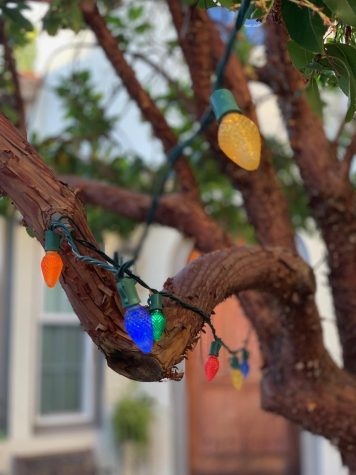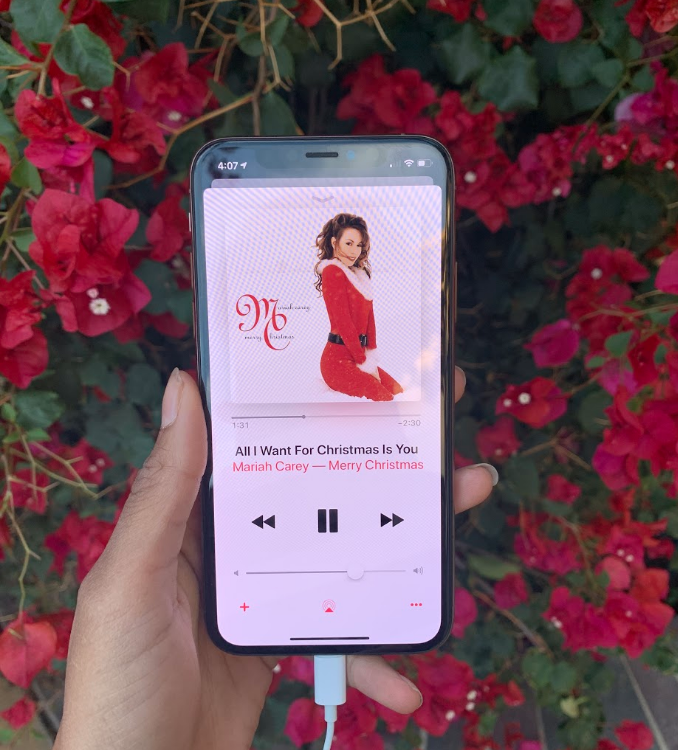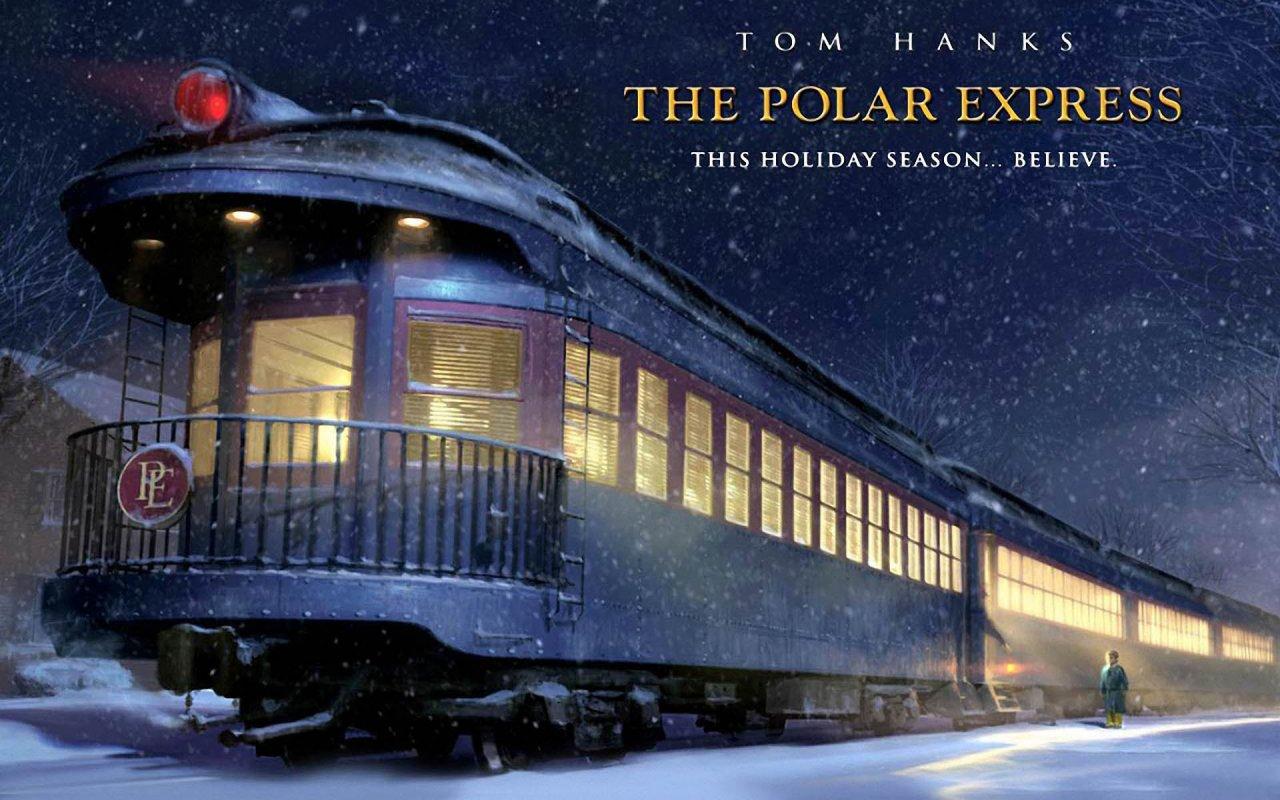Too Yule for school: The treble with Christmas music
Nilisha Baid
With red flowers in the background, Mariah Carey’s “All I Want For Christmas Is You” plays on an iPhone. According to Billboard, it was the top Holiday Song for 30 weeks last winter.
December 12, 2018
During the holidays, verses of Christmas music can be heard ringing through households across the country. Everyone knows the tune to “Jingle Bells” or “Rudolph the Red-Nosed Reindeer.” While Halloween has a couple of famous songs as well, for Thanksgiving or Easter, there aren’t any songs that immediately come to mind. In comparison, what makes Christmas music so catchy?
Unlike with other holidays, Christmas music accentuates the holiday atmosphere. During Thanksgiving, for most people, the spotlight is on the food, and over Easter, Christians visit their churches to celebrate the holiday. Despite its religious origins, the idea of Christmas, music included, has become popular among people of all cultures.
According to a video by Vox, popular songs over the years, ranging from Phil Spector’s “Christmas (Baby Please Come Home)” in 1972 to Mariah Carey’s “All I Want For Christmas Is You” in 1994. Not only do those two songs have similar intros, “All I Want For Christmas Is You” also contains similar elements to “White Christmas,” written in 1942 by Irving Berlin and performed by Bing Crosby. The two songs begin with a tonic chord before melting into a diminished two seven chord. Through these jazzy chords, Carey achieves a jazzy, classic feeling in her music.

A speaker pokes out of a green and white gift bag. Most performing arts groups use Christmas music during their performances at the Santana Row Tree Lighting and BAD day.
While each song has its own individual characteristics, ranging from upbeat bell chimes to more subdued piano notes, they tend to elicit the same nostalgic feeling, according to U.S. News.
Sophomore Vaishnavi Murari values how Christmas music reminds her of her childhood.
“It just makes me feel like I can stop worrying about everything and just have fun. It’s like I can go back to being a little kid who doesn’t have to worry about finals and school, and I can just enjoy the holidays,” she said. “I have this one memory of me and my family at a Christmas party, and everyone just started singing Christmas carols, and I remember just being really happy.”
For the past six years, Esha Gohil (9) has celebrated Christmas with her family, and each December, music is an integral part of their tradition.

Colorful Christmas lights hang on a tree. The tradition of carols first began thousands of years ago in Europe as a pagan celebration of the winter solstice.
“Every year, the first weekend of December, we get our tree, and my sister and I jam out to Christmas music all day,” she said. “When I was younger, we would always listen to Christmas music when we were in the car, so it just reminds me of simpler times.”
According to Whychristmas.com and ThoughtCo, the tradition of carols first began thousands of years ago in Europe as a pagan celebration of the winter solstice, but early Christians took over the holiday by giving people religious songs to sing instead. Over the centuries, the popularity of Christmas music fluctuated greatly. Although it became less popular by the middle ages, St. Francis of Assisi began including it in his nativity plays, which led to its popularity rising again. In England, when Oliver Cromwell and the Puritans took power, they stopped the singing of carols, but many citizens still sang them in secret. The tradition was eventually revived in the 18th century, which is when many modern songs were written.
During the 14th century, the theme of the songs revolved around a saint or the Virgin Mary and blended Latin and English, while today, they typically refer to the sensations of wintertime or the feeling of love. Within school, Christmas music impacts most performance groups, from Varsity Dance to Cantilena.
Kenya Aridomi (11), a member of Downbeat, appreciates how it brings him and his fellow singers together.
“Rather than doing choral music where we don’t really understand what we’re saying [because] it’s a different language, it’s something that we all shared in our childhood,” he said. “It’s a common childhood memory, and it’s sort of like reliving it even as we’re high schoolers.”


















![“[Building nerf blasters] became this outlet of creativity for me that hasn't been matched by anything else. The process [of] making a build complete to your desire is such a painstakingly difficult process, but I've had to learn from [the skills needed from] soldering to proper painting. There's so many different options for everything, if you think about it, it exists. The best part is [that] if it doesn't exist, you can build it yourself," Ishaan Parate said.](https://harkeraquila.com/wp-content/uploads/2022/08/DSC_8149-900x604.jpg)




![“When I came into high school, I was ready to be a follower. But DECA was a game changer for me. It helped me overcome my fear of public speaking, and it's played such a major role in who I've become today. To be able to successfully lead a chapter of 150 students, an officer team and be one of the upperclassmen I once really admired is something I'm [really] proud of,” Anvitha Tummala ('21) said.](https://harkeraquila.com/wp-content/uploads/2021/07/Screen-Shot-2021-07-25-at-9.50.05-AM-900x594.png)







![“I think getting up in the morning and having a sense of purpose [is exciting]. I think without a certain amount of drive, life is kind of obsolete and mundane, and I think having that every single day is what makes each day unique and kind of makes life exciting,” Neymika Jain (12) said.](https://harkeraquila.com/wp-content/uploads/2017/06/Screen-Shot-2017-06-03-at-4.54.16-PM.png)








![“My slogan is ‘slow feet, don’t eat, and I’m hungry.’ You need to run fast to get where you are–you aren't going to get those championships if you aren't fast,” Angel Cervantes (12) said. “I want to do well in school on my tests and in track and win championships for my team. I live by that, [and] I can do that anywhere: in the classroom or on the field.”](https://harkeraquila.com/wp-content/uploads/2018/06/DSC5146-900x601.jpg)
![“[Volleyball has] taught me how to fall correctly, and another thing it taught is that you don’t have to be the best at something to be good at it. If you just hit the ball in a smart way, then it still scores points and you’re good at it. You could be a background player and still make a much bigger impact on the team than you would think,” Anya Gert (’20) said.](https://harkeraquila.com/wp-content/uploads/2020/06/AnnaGert_JinTuan_HoHPhotoEdited-600x900.jpeg)

![“I'm not nearly there yet, but [my confidence has] definitely been getting better since I was pretty shy and timid coming into Harker my freshman year. I know that there's a lot of people that are really confident in what they do, and I really admire them. Everyone's so driven and that has really pushed me to kind of try to find my own place in high school and be more confident,” Alyssa Huang (’20) said.](https://harkeraquila.com/wp-content/uploads/2020/06/AlyssaHuang_EmilyChen_HoHPhoto-900x749.jpeg)









